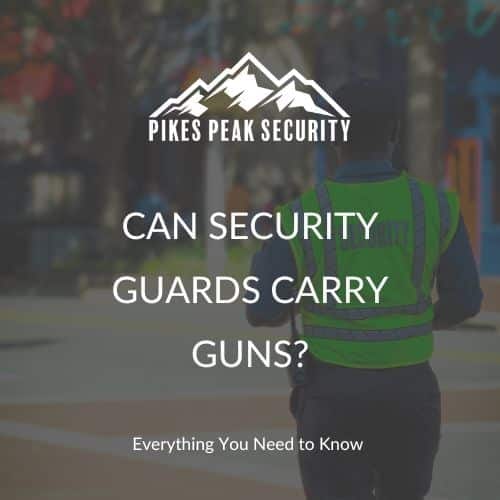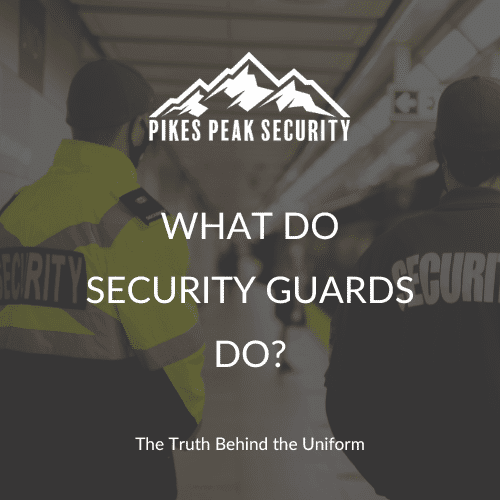One of our passions at Pikes Peak Security is workplace safety, which is why we offer workplace violence prevention services, workplace risk assessments, employee safety training, and traditional security services in a range of industries. We want your employees to feel safe at work, so your business can thrive.
But you need more than just high-quality security services to keep your business safe. A workplace safety plan outlines policies and procedures that will prepare your employees for any workplace threat, from falling on the job to coworker violence. So, let’s discuss the 6 crucial steps for creating a small business safety plan that works.
Do I Need a Small Business Safety Plan?
As a small business owner, you hold a great deal of responsibility when it comes to maintaining a safe workplace. Unfortunately, accidents can happen at any time, and workplace injuries can have a serious impact on both your employees and your business overall.
That’s why creating a workplace safety plan is so critical. Not only will it help keep your employees safe and healthy, but it can also reduce the risk of costly insurance claims or litigation. By taking a proactive approach to workplace safety, you’ll demonstrate your commitment to creating a workplace culture that prioritizes prevention and protection.
What Should My Safety Plan Include?

Typically a workplace safety plan will be divided into modules or chapters that discuss potential risks in the workplace. The safety plan will provide an overview of any preventative measures that are already in place, and outline the proper policies and procedures if an accident should occur.
For example, in restaurants, burns are a fairly common injury. So the relevant workplace safety module could include:
- Dress code requirements, like chef pants and non-slip shoes.
- Proper handling of hot dishes.
- First aid for burns.
- Where to seek treatment.
- And how to report the incident.
Steps for Creating a Safety Plan
Now, let’s get into how to create your small business safety plan:
1. Assess all possible risks.
Before you create any procedures or documentation, you’ll want to understand the safety risks present in your workplace. Some might be fairly obvious, such as with the kitchen example above, whereas others may take some digging. Here are a few ways to identify as many potential threats as possible:
- Interview employees.
- Contact your business insurance provider.
- Perform a walkthrough and/or observe your employees on shift.
- Review accident reports and previous injuries.
- Ask local safety experts, such as police officers, firefighters, or security companies about common safety issues.
Keep an ongoing list of potential threats. You won’t be able to address every possible safety concern in your plan, so think about the potential severity of the injury and prioritize accordingly.
2. Understand legal safety requirements.
Your safety plan must meet all legal safety requirements, such as those set by OSHA and the Department of Labor. Familiarize yourself with these regulations to ensure you create a plan that is compliant and thorough. You can find sample OSHA safety programs here that can be adapted to fit the needs of your business. Keep in mind that your industry may have additional requirements that are not included in these general templates.
3. Implement preventive measures.
Once you know the risks, it’s time to look into preventative measures. This could be anything from installing additional lighting in dark hallways to training employees on how to safely lift heavy objects. While your prevention methods may vary based on the industry and workplace hazards, there are some common safety suggestions that apply broadly. These include:
- Regular maintenance and cleaning.
- Adequate ventilation, temperature control, and lighting.
- Proper storage for chemicals or hazardous materials.
- Security measures like access cards or video surveillance.
- Active violence and first aid training programs.
4. Create documentation.
Now it’s time to document your safety plan. It’s important to include all the information we discussed earlier, such as potential risks, legal requirements, and preventive measures. Your plan should be written clearly so that it can be understood by anyone who reads it.
You’ll also want to create a system for regularly updating and reviewing your safety plan. This will ensure that the information remains relevant and up-to-date.
5. Train employees on new safety procedures.
Once the safety plan is in place, your employees need to be trained on the new policies and procedures. You’ll want to create a comprehensive training program that covers everything from proper lifting techniques to emergency response plans.
Be sure to include real-life scenarios whenever possible so that employees can gain valuable hands-on experience. Additionally, review the safety plan regularly to ensure that everyone is up-to-date on any changes.
6. Enforce safety rules and procedures.
Finally, it’s important to take a proactive approach when it comes to enforcing safety rules and procedures in your workplace. It may be tempting to overlook small infractions or try to brush them off, but this can have long-term consequences.
To ensure that your safety plan is effective, make sure to establish a system for monitoring compliance. You may choose to hand out verbal warnings or issue more formal disciplinary action if necessary.
Contact Pikes Peak Security for Safety Plan Support
Pikes Peak Security can help you assess physical security threats to your business and employees and take preventative measures, such as adding surveillance equipment or limiting access to your building. In addition to risk assessment, we also provide regular training sessions on topics ranging from first aid to active shooter response. So, if you need help preparing your employees for emergency situations, contact us today.








